The History Of FORD Capri
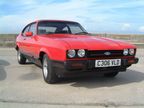
Ford Capri was a name used by the Ford Motor Company for three separate automobile models:
- The Ford Consul Capri coupe, produced by Ford of Great Britain between 1961 and 1964
- The Ford Capri coupe, produced by Ford Europe from 1969 to 1986
- The Ford Capri convertible, produced by the Ford Motor Company of Australia from 1989 to 1994.
The Capri name was also used by Ford's Lincoln-Mercury Division on a number of models which did not bear the Ford name:
- The Lincoln Cosmopolitan Capri, 1950 to 1951
- The Lincoln Capri, 1952 to 1959
- The Mercury Comet Capri, 1966
- The Mercury Capri, 1967
- The Capri, 1970 to 1977
- The Mercury Capri, 1979 to 1986
- The Mercury Capri, 1991 to 1994
The first use of the name Capri outside the USA was by Ford of Great Britain for a 2 door coupé version of the Ford Classic saloon. To really understand why this model was produced and in such limited numbers, one has to look at the history of the Ford Motor Company (UK) at that time. During the 1950's all bodies for Ford of Great Britain's passenger vehicles were built by outside body builders. Dearborn made it known in November 1960 that it wanted to purchase the rest of the share capital in Ford of Great Britain. This brought about some policy changes that had great influence into the styling of the coming models. Not the least the fact that they put their own people into Dagenham. The Ford Classic was a result of 4 years of intensive development. Approval for the project was given in autumn 1956. The Styling of the car was the last project undertaken by Colin Neale before he left Dagenham for Dearborn. The initial design requirements was for the Ford Classic to be a full range model, to take Ford into the new decade. Ford produced a full size estate (or Station Wagon) mock -up but it never reached production.
The Capri Project was code named "Sunbird", it took design elements from the Ford Thunderbird and the Ford Galaxie Sunliner. It was instigated by Sir Horace Denne, Ford's Export Director. He wanted a "Co-repondent's" car to add a little glamour to the export line. On it's September announcement it was initially for Export only. It was designed by Charles Thompson who worked under. It had sweeping lines, a large boot space and a pillarless coupé roof. The Ford Consul Capri went on sale to the domestic home market of Britain in January 1962: The bodies were sub-assembled by Pressed Steel Fisher, with only final assmbly taking place at Dagenham. Because it was intended as part of the Ford Classic range of cars, the body was well engineered but was complex and expensive to produce. With new production methods, time demands from Dearborn and a need to match opposition manufacturers in price, the Ford Classic and Consul Capri were almost doomed from the start. The Ford Classic ran from 61 - 63, and was replaced by the equally short lived Ford Corsair.
The Consul Capri was made to Ford Classic De-Luxe spec only, it offered many then unusual features, such as four headlights, variable speed wipers, disc brakes, dimming dashboard lights, and a cigar lighter. It was proclaimed as "The First Personal car from Ford of Great Britain" (Ford of Great Britain, sales literature, December 1961) Initially fitted with a 1340 cc 3 main bearing engine (model 109E), these earlier cars were considered underpowered and suffered from premature crankshaft failure. Engine capacity was increased in August 1962 to 1498 cc (model 116E), this engine was a vast improvement. The first 200 Capris were left-hand-drive cars for export including Europe and North America.
In Germany at the 1961 Frankfurt Auto Show, Ford sold 88 Capris.
In February 1963 a GT version (also 116E, ) was announced. The new GT engine, developed by Cosworth, featured a raised compression ratio to 9:1, a modifed head with larger exhaust valves and aluminium inlet manifold, a four branch exhaust manifold and most noticeably a Twin-Choke Webber Carburettor - This being the first use of this carburettor on a British production car. (this same engine was announced for use in the Ford Cortina in April 1963. The Consul Capri was the First genuine factory GT from Ford, as we know it. From 1961 to 1964 just on 19,421 Capris were sold, of which 2002 were GT models. The Consul Capri was discontinued in July 1964.
Overall the car was very expensive to produce and in the latter part of its production was running alongside the very popular Ford Cortina, sales were disappointing and the Consul Capri was removed from sale after just two and a half years. Just 1007 cars were sold in 1964,the last year of production, 412 of them being GT's . The Consul Capri (335) is one of the rarest cars from Ford of Great Britain.
The first Ford Capri to bear that precise name was introduced in January 1969 at the Brussels Motor Show, with sales starting the following month. The intention was to reproduce in Europe the success Ford had had with the North American Ford Mustang; to produce a European pony car. It was mechanically based on the Cortina and built in Europe at the Dagenham and Halewood plants in the United Kingdom, the Genk plant in Belgium, and the Saarlouis and Cologne plants in Germany. The car was named Colt during development stage, but Ford were unable to use the name, as it was trademarked by Mitsubishi.
Although a fastback coupé, Ford wanted the Capri Mark 1 to be affordable for a broad spectrum of potential buyers. To help achieve that, it was available with a variety of engines. The British and German factories produced different line-ups. The continental model used the Ford Taunus V4 engine in 1.3, 1.5 and 1.7L engine displacement, while the British versions were powered by the Ford Kent straight-4 in 1.3 and 1.6L form. The Cologne V6 2.0L served as initial range-topper. Until the end of the year, new sports versions were added: the 2300 GT in Germany, using a double-barrel carburettor with 125PS (92kW), and the 3000 GT in the UK, with the Essex V6, capable of 138hp (103kW).
In April 1970, Ford began selling the Capri outside Europe, in the North-American, South African and Australian markets. These versions were powered solely by the underpowered Kent 1.6 engine, but a Pinto straight-4 2.0L replaced it in 1971. The North American version featured new headlights and bumpers (to comply with U.S. DOT regulations), and carried no brand badge.
A new 2637cc version of the Cologne V6 engine assembled by Weslake appeared in September 1971, powering the Capri RS2600. This model used Kugelfischer fuel injection to raise power to 150PS (110kW), and was the basis for the Group 2 RS2600 used in the European Touring Car Championship. Fitted with the Weslake engine featuring their special all alloy cylinder heads. The RS2600 also received modified suspensions, a close ratio gearbox, lightened bodywork panels, ventilated disc brakes and aluminium wheels. The 2.6L engine was detuned in September for the deluxe version 2600 GT, with 2550cc and a double-barrel Solex carburettor. Germany's Dieter Glemser won the Drivers title in the 1971 European Touring Car Championship at the wheel of a Ford Köln entered RS2600 and fellow German Jochen Mass did likewise in 1972.
Mk1 facelift
The Capri proved highly successful, with 400,000 cars sold until 1970, and Ford revised it in 1972, to become what is known by enthusiasts as the Capri "Bis" or, in the UK, the "Mark 1 facelift" Capri.[citation needed] The car received a new and more comfortable suspension, rectangular headlights, enlarged taillights and new seats. The Kent engines were replaced by the Ford Pinto engine, and the previously UK-only 3000 GT joined the German lineup. In the UK the 2.0L V4 remained in use. The following year, 1973, saw the highest sales total the Capri ever attained, at 233,000 vehicles, and the 1,000,000th Capri sold in August.
In December, Ford replaced the RS2600 with the RS3100, with the Essex V6's displacement increased to 3098cc. Unlike its predecessor, it used a double-barrel Weber carburettor, and reached the same 150PS (110kW). Only 250 RS3100s were built for homologation purposes. However, the car was still competitive in touring car racing, and Ford Motorsport produced a 100-model limited edition with this new engine. The Group 4 RS3100’s engine was tuned by Cosworth into the GAA, with 3412cc, fuel injection, DOHC, four valves per cylinder and 435hp (324kW) in racing trim. The car also featured improved aerodynamics. Besides the racing RS3100, the GAA was also used in Formula 5000.
In February 1974, the Capri Mk2 was introduced. After 1.2 million cars sold, and with the 1973 oil crisis, Ford chose to make the new car more suited to everyday driving, with a shorter bonnet, larger cabin and the adoption of a hatchback rear door. By the standards of the day the mk2 was a very well evolved vehicle with very few reliability issues.
Although it was mechanically similar to the Mk1, the Capri 2 had a revised larger body and a more modern dashboard including a smaller steering wheel. The 2.0L version of the Pinto was introduced in the European model, and was placed below the 3.0L V6, although it was more powerful. The Capri still maintained the large square headlights, which became the easiest way to distinguish between a Mk2 and a Mk3. Larger disc brakes and a standard alternator finished the list of modifications.
In order to keep the sporty appeal of the car, Ford introduced the John Player Special limited edition, (known as the JPS) in March 1975, but in May 1976, and with sales decreasing, the intermediate 3.0 GT models disappeared to give way for the upscale 3.0 S and Ghia designations. In October 1976, production was limited to the Saarlouis factory only, and the following year the Capri left the American market with only 513,500 models sold.
The Capri Mk3 was referred to internally as "Project Carla", and although little more than a substantial update of the Mk2, it was often referred to as the Mk3. The first cars were available in March 1978, but failed to halt a terminal decline in sales. The concept of a heavily facelifted Capri 2 was shown at the 1976 Geneva show: a Capri 2 with a front very similar to the Escort RS2000 (with four headlamps and black slatted grille), and with a rear spoiler, essentially previewed the model some time before launch. The Mk3 featured improved aerodynamics, leading to improved performance and economy over the Mk2 and the trademark quad headlamps were introduced.
At launch the existing engine and transmission combinations of the Capri 2 were carried over, with the 3.0 S model regarded as the most desirable model although in truth the softer, Ghia derivative with automatic rather than manual transmission the bigger seller of the two V6 engined models.
The 3.0 S was used extensively in the TV series The Professionals, with characters Bodie driving a silver 3.0 S and Doyle a gold 3.0 S, which was credited with maintaining interest in the car in the UK.[citation needed]
Ford began to focus their attention on the UK Capri market as sales declined, realizing the car had something of a cult following there. Unlike sales of the contemporary 4 door Cortina, Capri sales in Britain were to private rather than fleet buyers who would demand less discounts, allowing higher margins with the coupé. Ford tried to maintain interest in 1979 with "X Pack" options from the performance oriented "Rallye Sport", or "RS" parts range. Although expensive and slow selling these proved that the press would enthusiastically cover more developed Capris with higher performance.
In 1981, the 3.0 V6 powerplant was dropped from the line-up, while a new sporty version debuted at the Geneva Motor Show, called the 2.8 Injection. The new model was the first regular model since the RS2600 to use fuel injection. Power rose to 160PS (118kW) giving a top speed of 210km/ h (130mph), but the car still had a standard four-speed gearbox. The Capri 2.8 Injection breathed new life into the range and kept the car in production 2-3 years longer than Ford had planned. The four-speed gearbox was replaced with a five-speed unit early on – at the same time Ford swapped the dated looking chequered seats for more luxurious looking velour trim. A more substantial upgrade was introduced in 1984 with the Capri Injection Special. This development used half leather seating and included a limited slip differential. Externally the car could be easily distinguished by seven spoke RS wheels (without the customary "RS" logo since this was not an RS vehicle) and color coded grille and headlamp surrounds. At the same time the 2.0L Capri was rationalized to one model the 2.0 S, which simultaneously adopted a mildly modified suspension from the Capri Injection. The 1.6 model was also reduced to one model, the 1.6 LS.
Although the Capri no longer had a racing career, Ford of Germany developed a limited edition, left hand drive only, turbocharged model with 190PS (140kW), which could propel the car to 220km/ h (137mph) in April 1982. This wild looking derivative featured widened bodywork and "RS" badging of the engine and wheels. Although rare and collectible it was not regarded as a car of equal stature to the later Tickford - the other Ford "official" turbo Capri.
The Tickford Capri used the 2.8 Injection (rather than the RS model which strangely used the Granada carburettor engine) and developed 205hp (153kW) this version also featured a luxury interior with optional full leather retrim and Wilton carpeting and headlining, large rear spoiler, color coded front grille, deeper bumpers and 'one off' bodykit designed by Simon Saunders, later of KAT Designs and now designer of the Ariel Atom.
The independent tuner Turbo Technics also released a 200hp (149kW) version, and a new 230hp (172kW) evolution which came supplied with a specially built gearbox. The Tickford Capri pricing issues meant that Ford also sanctioned the Turbo Technics conversion as semi-official, although only the German RS and British Tickford ever appeared in Ford literature as official Ford products.
Rear disc brakes were standard on the Tickford which featured numerous other suspension modifications. This model was essentially rebuilt by hand by Tickford at approximately 200 hours per car, several of those dedicated to reshaping the leading edge of the bonnet to mate with the redesigned grille and body kit. It sold fewer than 100 units.[citation needed] One problem was the relative price difference to the standard Capri Injection, with the Tickford version costing twice as much.
From November 1984 onwards, the Capri was sold only in Britain, with only right hand drive cars were made from this date. The 1.6 and 2.0 variants were rebranded with a new trim level – "Laser" – which featured a fully populated instrument pod, leather gear lever, leather steering wheel and an electric aerial along with colour-coded grille and mirrors. The last run limited edition "Brooklands" Green, 280 model, featuring a limited slip differential, full leather Recaro interior and 15 inch versions of the seven spoke 13 inch wheels fitted to the superseded Capri Injection Special. Ford originally intended to make 500 turbo charged vehicles (by Turbo Technics) complete with gold alloy wheels and name it the Capri 500 but a change of production planning meant a name change to Capri 280 as the cars were simply the last models ran down the production line. A total of 1,038 Capri 280s were built. Contrary to some reports these cars were not called "Capri 280 Brooklands", the latter name of the famous Surrey race track only being applied to the paint colour rather than the car itself.
When the last Capri was made on 19 December 1986, 1,886,647 cars had rolled off the production line. Production had ended at Halewood, UK in 1976 and the Capri was made exclusively in Germany from 1976 to 1986. Most of those (more than a million) were the Mk 1, mostly because the Mk 1 sold well in North America and Australia, while the Mk 2 and Mk 3 were only exported outside Europe (to Asia and New Zealand) in limited numbers.
The Capri is remembered for the classic advertising slogan "The car you always promised yourself". A North American advertising campaign featured a shorter line: "Capri: The Sexy European".
North America
From 1970 to 1977, the Capri was sold in North America through Ford's Lincoln/ Mercury Division. These cars carried no brand identification, only the "Capri" name. They were known however as the "Mercury Capri".[citation needed]
Originally, the Cologne-built Capri 1600 was fitted with a British 1.6L Kent engine. Initial output was just 64hp (48kW). The 1971 Capri 2000 featured the Cologne-built 2.0L OHC engine for much-improved performance from 101hp (75kW). A Capri 2600 GT was offered in 1972 with a 2.6L Cologne V6 which produced a substantial 120hp (89kW).
In 1979, no longer importing the Ford Capri, Ford began selling a new Mercury Capri which was essentially a re-badged Ford Mustang. It was initially available with a 88hp (66kW) 2.3L 4-cylinder. Later, an optional 302 (5.0L) V8 became available. In 1984, the Capri was available with a 175hp (130kW) turbocharged 2.3L 4-cylinder engine as well as a 165hp (123kW) 302 V8. While lighter than the V8 model, the Capri Turbo lacked the torque of the V8 and suffered from turbo lag, making it slower. Next year, the V8 was rated at 180hp (134kW) and the turbo model was dropped. This generation of Mercury Capri should not be confused with the Europe based Capri and it never became nearly as popular as the Ford Mustang, although it was essentially identical, save for cosmetic details. In 1985 and 86 the Capri 5.0 motor was the same as the Mustang-210hp in 85 200hp in 86.After 1986, the Mercury Capri was dropped.
In 1991, a new Mercury Capri was introduced, this model being fully imported from Australia (see below). It was a convertible with four seats, front wheel drive and a 100hp (75kW) 4 cylinder 1.6L engine. It was also available with a 132hp (98kW) 1.6 turbo engine. Both versions were dropped after 1994.
South Africa
Ford of South Africa assembled the Capri from 1970 to 1972 with a similar model range to the UK. No facelift models or RS variants were marketed in South Africa. About 500 Capris were converted by specialist Basil Green Motors to run the 302 Ford Windsor V8 engine. These models were known as the Capri Perana and were very successful in local touring car events, winning the 1970 South African championship and, in a different format, the 1971 championship as well. No Mark 2 and Mark 3 Capris were exported to, or built in South Africa. Most of the Capris that survive in South Africa are 1.6 or 3.0 models. Fewer 1.3 and 2.0 models survive.[citation needed]
Australia
The Ford Motor Company of Australia manufactured the European designed Mark 1 Capri at its plant in the Sydney suburb of Homebush from 1969 until 1972. The Capri was offered to the Australian market from 3rd May 1969 as the 1600 Deluxe and the 1600 GT, using the 1.600L Ford Kent OHV engine. On 25th February 1970, the 3000 GT was launched, equipped with the 3.0L Ford Essex V6. At the same time the 1600 GT became the 1600 XL whilst the 1600 Deluxe remained unchanged.
Sales of the car began very well but began to dwindle as a result of local and imported competitor vehicles in the small to mid sized sports sedan segments[citation needed]. In November 1972, production of the Capri ended in Australia, with a total of 15,122 vehicles having been made. Neither the Mark 1 facelift Capri nor the subsequent Mark 2 and Mark 3 models were ever produced in Australia.
In 1973, Ford Australia imported fifty Capri RS3100 models. Many of the surviving cars are well preserved and some were used in competitive motorsport.[citation needed].
Ford Capri SA30
The Ford Capri name was revived in Australia in 1989. The Australian Capri, codenamed the SA30, was a convertible designed to rival the Mazda MX-5. Ironically, it used Mazda 323 engines and mechanicals which Ford Australia had adopted as the basis of the Laser. It had a bodyshell designed by Ghia and an interior by ItalDesign. However, by comparison with the MX-5, it was dated by the time of its release – some two years after its originally scheduled date, and its Laser underpinnings meant front-wheel-drive rather than the MX-5's more driver-focused RWD.
Two models were originally offered: a standard 1.6L model, and a turbocharged variant, with 136PS (100kW).
The Australian-built Capri was intended primarily for export to the US. Exports began in 1991, as the Mercury Capri, and sales briefly exceeded those of the MX-5, but then dropped rapidly, so production ceased in 1994. The car was plagued by quality problems and recalls, although it eventually had success in the early 1990s with models modified by Tickford.
An interesting point was that the retail price of a US specification Capri in the US was less than the retail price of an Australian specification Capri in Australia. Approximately 90% of production was exported to the US and the increased shipping costs were offset by the reduced cost of manufacturing the "mainstream" left hand drive model compared with the small volume right hand drive model for the Australian market.
The 1989-94 Capri was assessed in the Used Car Safety Ratings 2006 as providing "worse than average" protection for its occupants in the event of a crash. It was also highly criticized as commonly having leaking roof problems, even after multiple replacements from Ford Dealerships. This was eventually resolved by a new roof sealing system, and 100% testing in the factory.
The British magazine Auto Express and German magazine Stern have shown computer drawings of a proposed Focus-based Capri, with Auto Express advancing a 2005 release date in their July 2002 issue. In September 2003, Ford presented the Visos concept-car, a hatchback coupé, in the Frankfurt Auto Show. However, none of these examples have made it into production. In May 2008 Auto Express once again started speculation of a possible new Capri using computer generated images based on the Visos concept, the car is said to share its platform with the Focus ST using engines from the current Focus range, meaning it will have a front engine front wheel drive layout, a top of the range RS may feature a 3.2 litre 6 cylinder engine and four-wheel drive. The car will continue the Kinetic design theme seen on the current Mondeo, S-Max and Galaxy. It is set to be officially revealed as a concept in 2009.[citation needed]
- Capri Club International
- Ford Capri Legend
- Mercury Capri Resource
From Wikipedia, the free encyclopedia
More About FORD Capri
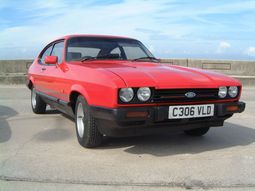
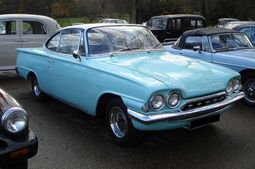
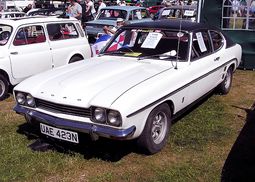
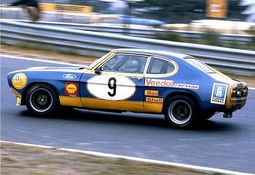
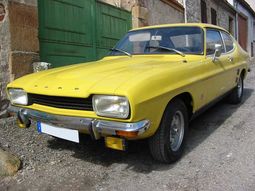
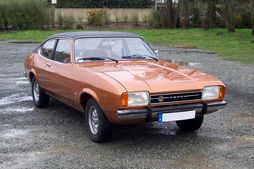
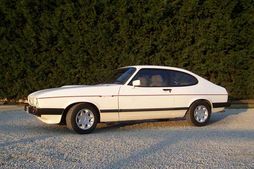
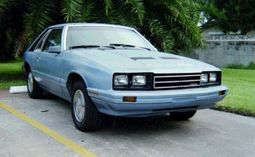
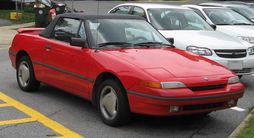
|